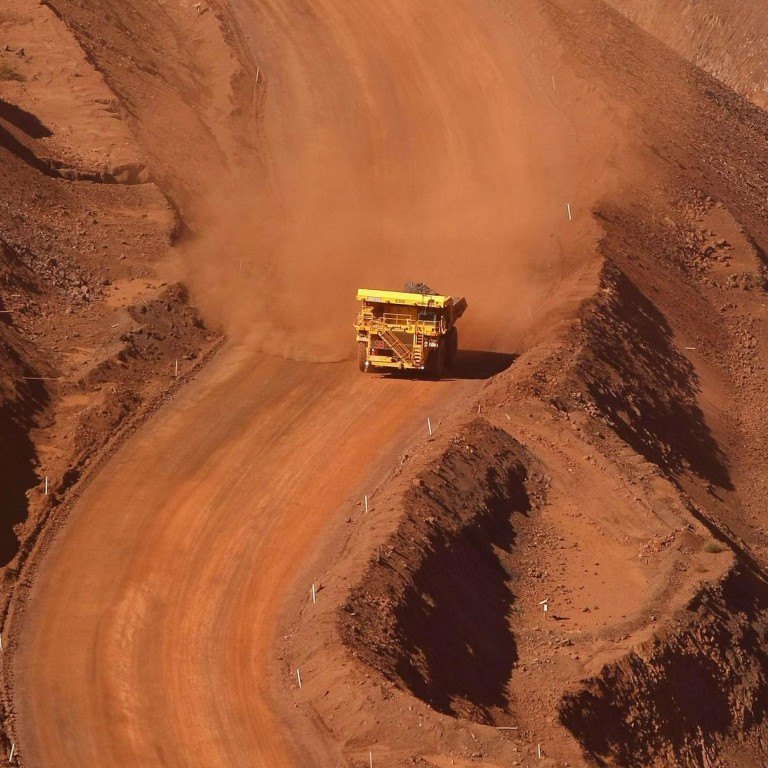
Slowing China just part of the story on iron ore slump
Rise in inventories, nudged by commodity's use as collateral in financing deals, is a key factor
Conventional thinking is that iron ore prices have plunged this year because of worries about China's economic growth outlook, but it is possible the reverse is the case.
The 16 per cent drop in spot Asian iron ore between February 17 and Monday is more than likely a cause of concern about China's economy, rather than a symptom of malaise in the world's biggest commodity consumer. While this sounds like a chicken-and-egg debate, if one views iron ore's decline, along with similar falls for copper, as raising concern about China, then looking at the dynamics behind the decrease in prices can be illuminating.
The reasons most often cited for iron ore's drop are a weakening steel demand growth outlook in China and an increase in available supply. There is truth in these arguments but they are far from complete explanations.
Prices may have further shortterm downside as inventories are sold off to repay financing
On the supply side, it's true that Australian miners have increased output, and more supply is expected in the next few years from both Australia and No2 exporter Brazil. But so far they have been able to sell all of their output, and while traders say the market is well supplied, there isn't much talk of significant oversupply driving down prices.
On the demand side, China's steel output has recovered, rising 5.9 per cent to 2.08 million tonnes a day in the last eight days of February from the preceding 10-day period, said the China Iron and Steel Association. This is also up from the 2.07 million tonnes daily average for last year, showing that the output is still growing.
Steel inventories remain near record highs, although they have declined recently, dropping 5.9 per cent to 16.3 million tonnes at major mills in the last week of February. The data suggests that iron ore demand should remain solid, and the risk of an unsustainable rise in steel inventories seems to be reducing, especially with the major construction season coming.
So, why have iron ore prices fallen so sharply to put them down 20 per cent now since the start of the year?
One likely explanation is the rapid rise in inventories at Chinese ports, which reached a record 105 million tonnes in the week to last Friday. Since the start of 2012 there has been a strong inverse correlation between iron ore inventories at Chinese ports and the spot price.
When the inventories reached a 2012 high of 101 million tonnes in July that year, prices started to tumble, eventually dropping 36 per cent from July 10 to its low of US$86.70 a tonne on September 5. Prices then started to rise as inventories started to decline, peaking at US$158.90 a tonne on February 20 last year, while inventories bottomed at 74.9 million tonnes on April 26.
What followed was a period of relative stability for both prices and inventories, but when the latter started to rise sharply from August, prices eventually responded by starting a downtrend in early December.
Why did iron ore inventories rise so quickly? Partly because prices were declining, but also because of the advent of using the steel-making ingredient as collateral in financing deals. As much as a quarter of current stocks are said to be tied to these credit deals, which had previously been based mostly on copper.
Recent reports suggest that the authorities are keen to crack down on this practice, and they also want to lower credit extended to uncompetitive steel mills in a bid to force a rationalisation of the overcapacity plaguing the sector. If this is the case, it does suggest that iron ore prices may have further short-term downside as inventories are sold off to repay financing.
The rationalisation of the steel industry is likely to be a positive for imports, though, as they tend to be of higher quality than domestic iron ore and offer better economics to more modern producers. Also, rationalisation of the steel sector is probably not as critical for iron ore demand as might be feared.
China plans to cut about 60 million tonnes of steel capacity by 2017, which is about 6 per cent of the more than one billion tonnes the industry can produce. Given steel output in China is forecast to rise some 3 per cent to 810 million tonnes this year, there is clearly room for much deeper cuts to get rid of inefficient capacity. Lower iron ore prices tend to force high-cost domestic miners to idle production, another positive for import volumes, if not prices.
It's also worth noting lower iron ore prices are ultimately a positive for the Chinese economy, and will help restore the health of the steel sector.

